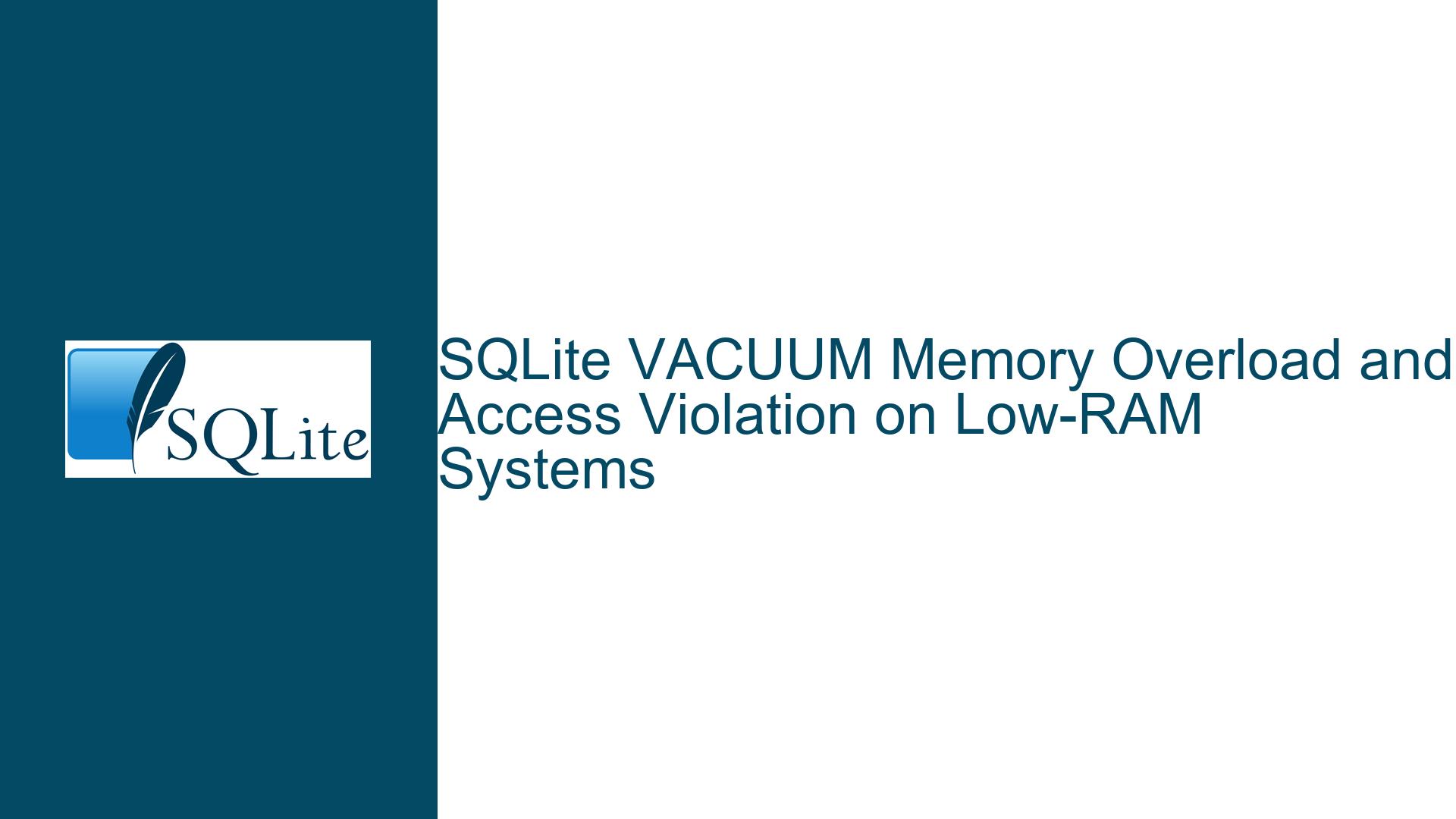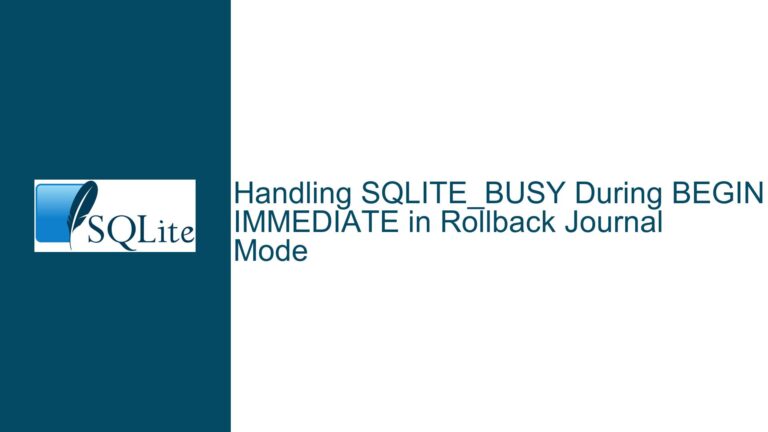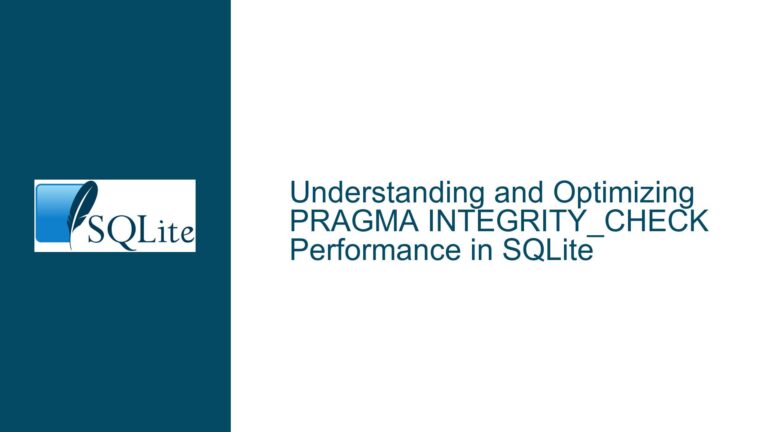SQLite VACUUM Memory Overload and Access Violation on Low-RAM Systems
SQLite VACUUM Memory Consumption and Access Violation Errors
The core issue revolves around the SQLite VACUUM command causing excessive memory consumption and subsequent application crashes on systems with limited RAM, particularly when operating in conjunction with memory-intensive applications like Firefox. The crash manifests as an access violation error (0xC0000005), indicating that the application attempted to access an invalid memory location. This issue is exacerbated when the database file is large (e.g., 645MB) and the system has insufficient free memory to accommodate the temporary storage requirements of the VACUUM operation. Notably, the problem does not occur on systems with more RAM or when the database file is smaller.
The VACUUM command in SQLite rebuilds the database file, repacking it into a minimal amount of disk space. This process involves creating a temporary copy of the database, which can significantly increase memory usage, especially if the PRAGMA temp_store setting is configured to use memory (MEMORY) instead of disk (FILE). On systems with limited RAM, this can lead to memory exhaustion, forcing the operating system to terminate the application to prevent system instability.
The error code 0xC0000005 (STATUS_ACCESS_VIOLATION) is a critical Windows error indicating that the application attempted to read or write to an invalid memory address. This error is often triggered by memory corruption, insufficient memory, or improper memory management. In this context, it is likely caused by the SQLite process attempting to allocate or access memory that is no longer available due to system memory exhaustion.
PRAGMA temp_store and Cache Size Settings Impacting Memory Usage
The primary cause of the memory overload and subsequent crash is the interaction between SQLite’s PRAGMA temp_store setting and the system’s available memory. When PRAGMA temp_store is set to MEMORY, SQLite stores temporary data in RAM instead of on disk. While this can improve performance on systems with ample memory, it becomes problematic on systems with limited RAM, especially when processing large databases.
Additionally, the PRAGMA cache_size setting plays a significant role in memory consumption. The cache_size parameter determines the maximum number of database pages that SQLite will hold in memory at once. A higher cache_size value increases memory usage, which can be beneficial for performance but detrimental on low-RAM systems. In the reported case, setting cache_size to 65536 (256MB) resulted in memory usage ballooning to around 600MB during the VACUUM operation, pushing the system to its limits.
The combination of a large database file, PRAGMA temp_store = MEMORY, and a high cache_size value creates a perfect storm for memory exhaustion. When another memory-intensive application (e.g., Firefox) is running concurrently, the system’s available memory is further reduced, increasing the likelihood of an access violation error.
Optimizing PRAGMA Settings and Implementing Memory-Efficient VACUUM Strategies
To resolve the memory overload and access violation issues, the following troubleshooting steps and solutions can be implemented:
1. Configure PRAGMA temp_store to Use Disk Storage
Setting PRAGMA temp_store to FILE ensures that temporary data is stored on disk rather than in memory. This significantly reduces memory usage during the VACUUM operation, making it more suitable for low-RAM systems. The following SQL command can be used to configure this setting:
PRAGMA temp_store = FILE;
2. Adjust PRAGMA cache_size to a Lower Value
Reducing the cache_size parameter limits the amount of memory SQLite uses for caching database pages. For low-RAM systems, a lower value (e.g., 2000 pages, which is approximately 8MB for a 4096-byte page size) is recommended. This can be configured using:
PRAGMA cache_size = 2000;
3. Monitor and Limit Concurrent Memory-Intensive Applications
Running memory-intensive applications like Firefox alongside SQLite operations can exacerbate memory pressure. To prevent crashes, ensure that no other memory-hungry applications are running during critical database operations like VACUUM. If this is not feasible, consider upgrading the system’s RAM to accommodate the combined memory requirements.
4. Use Incremental VACUUM for Large Databases
For very large databases, consider using the PRAGMA incremental_vacuum command instead of VACUUM. Incremental VACUUM processes the database in smaller chunks, reducing the memory footprint. This approach is particularly useful for systems with limited RAM. The following commands can be used to enable and execute incremental VACUUM:
PRAGMA auto_vacuum = INCREMENTAL;
PRAGMA incremental_vacuum;
5. Implement Database Backup and Restore as an Alternative to VACUUM
In some cases, performing a backup and restore of the database can achieve similar results to VACUUM without the same memory overhead. This involves exporting the database to a SQL script and then re-importing it into a new database file. The following steps outline this process:
# Export the database to a SQL script
sqlite3 old.db .dump > backup.sql
# Create a new database and import the script
sqlite3 new.db < backup.sql
6. Upgrade SQLite and System Components
Ensure that the latest version of SQLite is being used, as newer versions may include optimizations and bug fixes that reduce memory usage. Additionally, updating the operating system and related libraries (e.g., Tcl/Tk) can improve stability and performance.
7. Analyze and Optimize Database Schema
Review the database schema and queries for potential optimizations. Removing unused indexes, optimizing table structures, and rewriting inefficient queries can reduce the overall memory and disk space requirements, making VACUUM operations less resource-intensive.
8. Use External Tools for Memory Monitoring and Management
Utilize system monitoring tools to track memory usage during VACUUM operations. Tools like Windows Task Manager, Process Explorer, or third-party utilities can provide insights into memory consumption patterns and help identify bottlenecks.
9. Consider Database Sharding or Partitioning
For extremely large databases, consider sharding or partitioning the data into smaller, more manageable chunks. This approach reduces the size of individual database files, making VACUUM operations less resource-intensive.
10. Test and Validate Changes in a Controlled Environment
Before applying changes to a production environment, test them in a controlled setting to ensure they resolve the issue without introducing new problems. Use a copy of the production database and simulate the workload to validate the effectiveness of the optimizations.
By implementing these strategies, the memory overload and access violation issues associated with SQLite VACUUM operations on low-RAM systems can be effectively mitigated. These solutions not only address the immediate problem but also contribute to the overall stability and performance of the database system.






